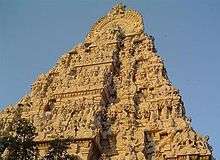Kanchi Kamakoti Peetham
| Acharya: Sri Jayendra Saraswati Swamigal | |
|---|---|
 | |
| Location | Kanchipuram |
| Founder | [[]] |
| First Acharya | [[]] |
| Formation | 1823 |
| Website | http://www.kamakoti.org/ |
Kanchi Kamakoti Peetham is a Hindu monastic institution located in Kanchipuram, Tamil Nadu kanchipuram is one of the five pancha-bhUta-sthalas ("Temples denoting the five elements"). The five pancha-bhUta-sthalas or material sites represent earth (Kanchipuram), sky (Chidambaram), air (Kalahasti), fire (Thiruvannamalai), and water (Thiruvanaikoil). It is known as Shri Kanchi Kamakoti Peetam, andThe head of the matha is referred to as a "Sankaracharya".
The Kanchi matha has been gaining prominence since the 18th century, when it was at Kumbakonam. Today, it is one of the most important religious institutions in South India.
History
The mutt is founded by the Adi Sankara, ]].[1][2]
HH Sri Jayendra Saraswathi, the 69th Shankaracharya and his successor the 70th Shankaracharya, HH Sri Sankara Vijayendra Saraswathi are the current pontiffs, before which, the mutt was headed by HH Sri Sri Chandrasekharendra Saraswati Mahaswamiji.
The Kamakoti Peetam however, traditionally refers to Kamakshi, referred popularly as Kamakodi. 'Kamakodi' is of Tamil origin, referring to Goddess Durga. 'Kodi' refers to Durga in the ancient Tamil Sangam literature. Kancheepuram is referred to as Kanchi. The Vyakarana Mahabhashya of Patanjali uses the word 'Kanchi' and it can be thus understood that the word Kanchi also has a Sanskrit base. Under the guidance of Sureshvarachaya, Adi Shankara appointed Sarvajnatman as the second Peetadhipathi. [3]
Chronological list of Sankaracharyas
As per claims of the The Kanchi Mutt (erstwhile kumbakonam mutt ) it was established by Adi Sankara in 482 BC though Adi Sankaras historically accepted period is 8th century AD. The following order of guru parampara given by the mutt is subject to proof of existence of the mutt prior to 1823.
The chronological list of Guru Paramapara of the matham follows:[4]
- Adi Sankara Bhagavatpada (482 BC-477 BC)
- Suresvaracharya (477 BC-407 BC) ( one of the four diciples who is the first guru of singeri mutt. kanchi mutt was reportedly not one of the four mutts established by Adi Sankara )
- Sarvajnatman (407 BC-367 BC)[5]
- Sathyabodhendra Saraswati (367 BC-268 BC)[6]
- Jnanandendra Saraswati (268 BC-205 BC)
- Suddhanandendra Saraswati (205 BC-124 BC)
- Aanandaghanendra Saraswati (124 BC-55 BC)
- Kaivalyanandayogendra Saraswati (55 BC-28 AD)
- Krpa Sankarendra Saraswati (28 AD-69 AD)
- Sureswara Saraswati (69 AD-127 AD)
- Sivananda Chidghanendra Saraswati (127 AD-172 AD)
- Chandrasekharendra Saraswati (172-235)
- Satchidghanendra Saraswati (235-272)
- Vidyaghanendra Saraswati (272-317)
- Gangadharendra Saraswati (317-329)
- Ujjvala Sankarendra Saraswati (329-367)
- Sadasivendra Saraswati (367-375)
- Shankarananda Saraswati (375-385)
- Martanda Vidyaghanendra Saraswati (385-398)
- Muka Sankarendra Saraswati (398-437)
- Chandrasekharendra Saraswati II (437-447)
- Bodhendra Saraswati (447-481)
- Satchisukhendra Saraswati (481-512)
- Chitsukhendra Saraswati (512-527)
- Satchidanandaghanendra Saraswati (527-548)
- Prajnaghanendra Saraswati (548-565)
- Chidvilasendra Saraswati (565-577)
- Mahadeve11dra Saraswati I (577-601)
- Purnabhodhendra Saraswati (601-618)
- Bhodhendra Saraswati II (618-655)
- Brahmanandaghanendra Saraswati (655-668)
- Chidanandaghanendra Saraswati (668-672)
- Satchidananda Saraswati (672-692)
- Chandrasekharendra Saraswati III (692-710)
- Chitsukhendra Saraswati (710-737)
- Chitsukhanandendra Saraswati (737-758)
- Vidyaghanendra Saraswati III (758-788)
- Abhinava Sankarendra Saraswati (788-840)
- Satchidvilaasendra Saraswati (840-873)
- Mahadevendra Saraswati II (873-915)
- Gangadharendra Saraswati II (915-950)
- Brahmanandaghanendra Saraswati (950-978)
- Anandaghanendra Saraswati (978-1014)
- Purnabhodhendra Saraswati II (1014-1040)
- Paramasivendra Saraswati I (1040-1061)
- Sandranandabhodhendra Saraswati (1061-1098)
- Chandrasekharendra Saraswati IV (1098-1166)
- Advaitanandabodhendra Saraswati (1166-1200)
- Mahadevendra Saraswati III (1200-1247)
- Chandrachudendra Saraswati I (1247-1297)
- Vidyateerthendra Saraswati (1297–1385)
- Sankaranandendra Saraswati (1385–1417)
- Purnananda Sadasivendra Saraswati (1417–1498)
- Vyasachala Mahadevendra Saraswati (1498–1507)
- Chandrachudhendra Saraswati II (1507–1524)
- Sarvajna Sadasiva Bhodhendra Saraswati (1524–1539)
- Paramasivendra Saraswati II (1539–1586)
- Atma Bodhendra Saraswati (1586–1638)
- Bodhendra Saraswathi (1638–1692)
- Advaitatma Prakasendra Saraswati (1692–1704)
- Mahadevendra Saraswati IV (1704–1746)
- ChandrasekharendraSaraswati V (1746–1783)
- Mahadevendra Saraswati V (1783–1813)
- Chandrasekharendra Saraswati VI (1813–1851)
- Sudarsana Mahadevendra Saraswati (1851–1891)
- Chandrasekharendra Saraswati VII (1891 - 7 February 1907)
- Mahadevendra Saraswathi V (7 February 1907 – 13 February 1907)
- Chandrashekarendra Saraswati (13 February 1907 – 3 January 1994)
- Jayendra Saraswathi (3 January 1994- Present)
- Shankara Vijayendra Saraswati (successor)
References
- ↑ Roshen Dalal (18 April 2014). Hinduism: An Alphabetical Guide. Penguin Books Limited. p. 613. ISBN 978-81-8475-277-9.
- ↑ Varanasi Raj Gopal Sharma (1987). Kanchi Kamakoti Math, a Myth. Ganga-Tunga Prakashan.
- ↑ http://www.kamakoti.org/
- ↑ "History of the Kanchi Sankaracharya Math and Acharaparampara". www.kamakoti.org. www.kamakoti.org. Retrieved 1 November 2016.
- ↑ Encyclopedia of Indian Philosophies. Advaita Vedānta from 800 to 1200. Motilal Banarsidass Publishe, 2006. p. 435. ISBN 978-81-208-3061-5.
- ↑ "Schools of Philosophy". hindupedia.com. hindupedia.com. Retrieved 1 November 2016.
External links
Coordinates: 12°48′58″N 79°41′24″E / 12.816°N 79.690°E